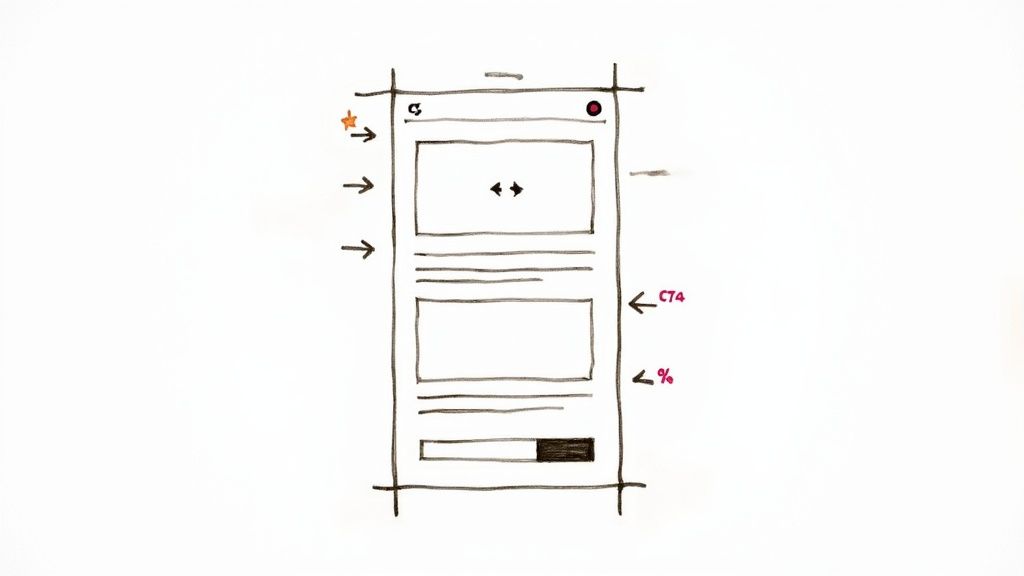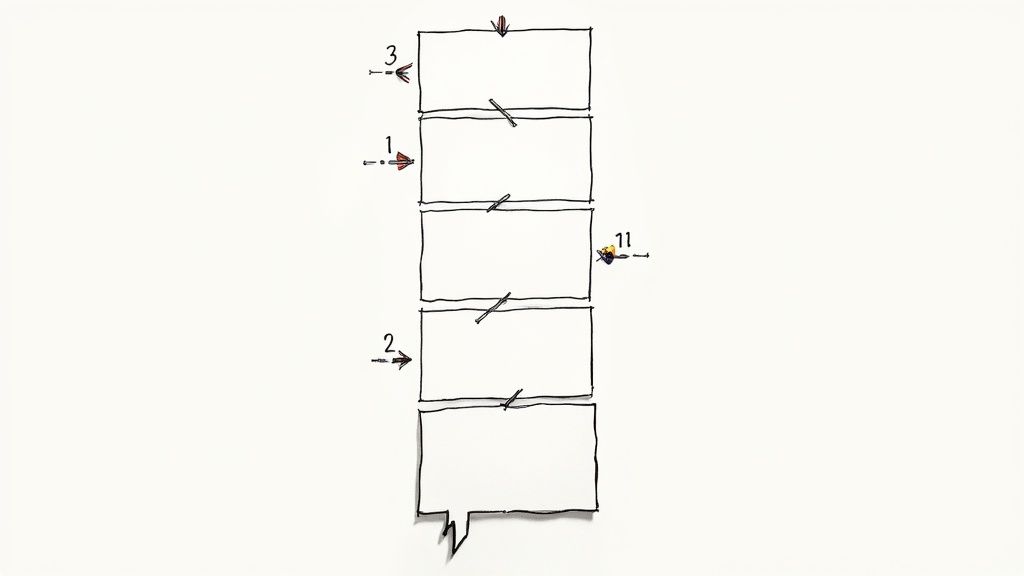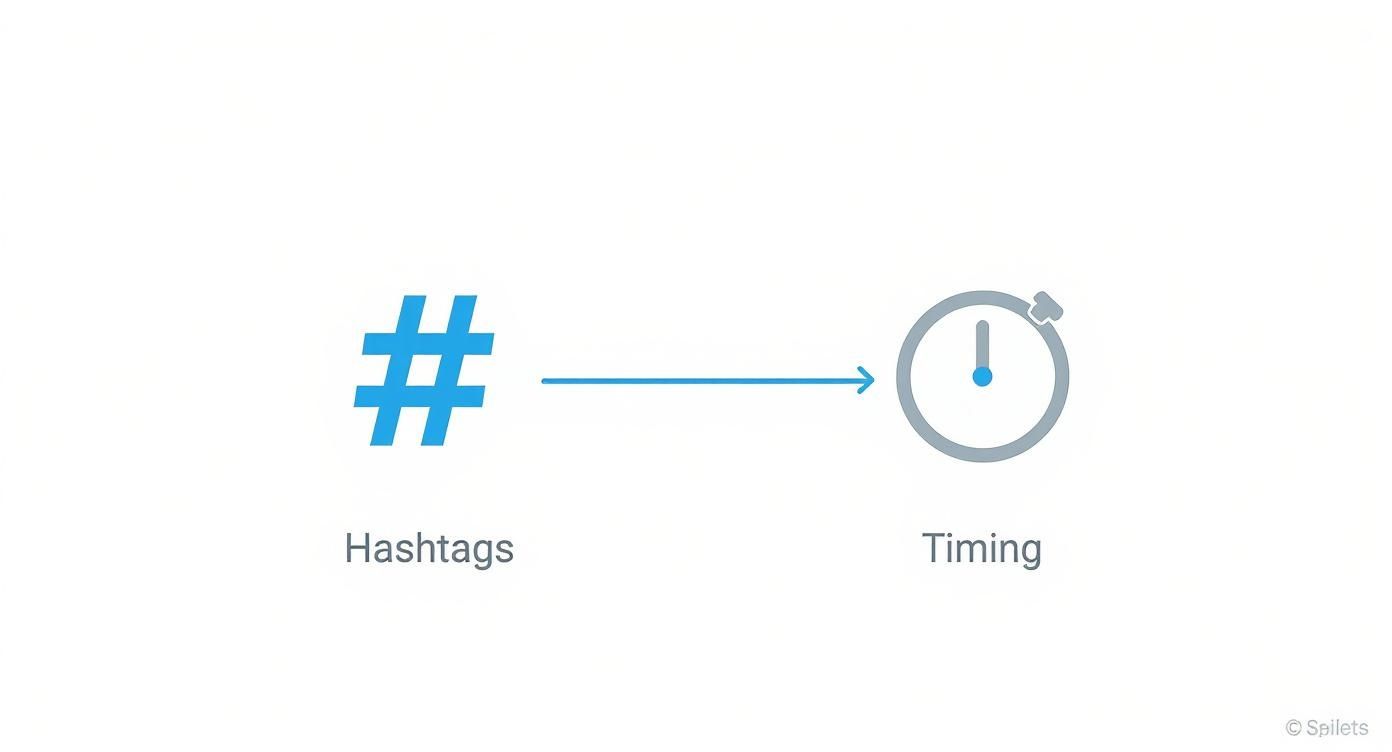Knowing how to tweet well is more than just firing off quick updates. It’s your key to a massive, global conversation. But getting it right is tough. You’re trying to build your brand and connect with your audience, but often your tweets get lost in the noise. A single great tweet can spark a viral moment, but consistently creating them feels impossible.
Why Learning How to Tweet Still Matters

Does it ever feel like you’re shouting into the void on X? It’s a common frustration. You spend real time crafting what feels like a solid post, only for it to disappear into the feed with zero engagement. It’s enough to make anyone wonder if the effort is even worth it.
We’re here to tell you it absolutely is—but only if you’re strategic about it.
Mastering the art of the tweet is a genuine game-changer. It’s not about broadcasting random thoughts. It’s a powerful way to build a personal brand, carve out a space as a thought leader, and open a direct line of communication with your community and customers. A single, well-crafted post can create an authentic connection that thousands of dollars in old-school advertising could never buy.
The Real Impact of a Great Tweet
You have to start seeing every tweet as a fresh opportunity. It’s a chance to share what you know, let your brand’s personality shine, or kick off a conversation that actually matters. Once you learn how to tweet with purpose, you stop being part of the noise and start building real relationships. For any business, that translates directly into tangible results.
A strategic presence on X is one of the most effective ways to generate qualified leads and build brand loyalty. It allows you to engage with potential customers in real-time, answer their questions, and demonstrate your value long before they ever visit your website.
This consistent, day-in-day-out engagement is what separates the accounts that grow from the ones that stagnate. It’s not about a one-off viral hit; it’s about showing up consistently with content people actually want to read. Of course, that’s where the real problem starts. The pressure for a constant stream of high-quality content leads to serious burnout.
Overcoming the Consistency Challenge
The demand to post multiple times a day is a huge roadblock. Are you struggling to find new ideas every single day? This is where having the right tools makes all the difference. Imagine, instead of racking your brain for content, you could take a single blog post and have a tool like EchoWriteAI instantly spin it into a full calendar of engaging tweets.
This solves your consistency problem, freeing you up to focus on what really matters: genuine interaction with your audience.
The platform itself is a global powerhouse, with X now reaching over 611 million monthly active users worldwide. With over 500 million tweets flying out every day, it’s a central hub for news, culture, and conversation. Learning how to carve out your space in this massive arena is a skill that pays off, connecting you to an incredibly vast and active audience. You can see the latest X user growth stats for yourself over at Analyzify.
Ultimately, learning how to tweet is about learning how to communicate effectively in a fast-moving world. For a deeper look at growing your following, check out our guide on how to increase followers on Twitter.
The Anatomy of a High-Impact Tweet

Ever feel like you’re shouting into the void? You put out what you think is a solid post, only to be met with crickets. It’s frustrating, and it’s a clear sign that your approach needs a tune-up. The problem is that most people focus only on the message, ignoring the other critical pieces that make a post stop someone in their tracks.
Tweets that take off aren’t random luck. They follow a specific, repeatable formula. So, let’s pull back the curtain and look at the blueprint for crafting content that actually gets seen, shared, and remembered.
Nail the Scroll-Stopping Hook
You have less than a second to grab someone’s attention. Your first line—the hook—is everything. If it’s weak, the rest of your masterpiece might as well not exist.
The best hooks are pattern-interrupts. They make people pause. This could be a bold, counterintuitive statement, a provocative question, or a jaw-dropping statistic. The goal isn’t to write clickbait; it’s to spark genuine curiosity.
For example, instead of a flat “AI is changing marketing,” try something with teeth: “90% of your marketing strategy will be obsolete in 18 months. Here’s why.” See the difference? The second one creates instant intrigue and promises a real payoff.
Deliver a Clear, Punchy Message
Okay, you’ve got their attention. Now what? Your message has to deliver value, and fast. This is where clarity crushes complexity. Get to the point.
Zero in on one single, powerful idea. What’s the one thing you need your audience to take away? Build your tweet around that core concept using simple language and short, punchy sentences. Use line breaks to make your post easy to scan. A great message solves a problem, offers a fresh perspective, or shares a relatable story.
The Undeniable Power of Visuals
Let’s be blunt: tweets with images, GIFs, or videos blow text-only posts out of the water. Visuals shatter the monotony of the feed and can communicate tone, emotion, and context in ways words just can’t.
But don’t just slap a random stock photo on it. The visual has to earn its place by being directly relevant to your message. Think about using:
- A compelling chart or graph to make your data pop.
- A short video clip to show, not just tell.
- A relatable GIF to inject some much-needed humor and personality.
- A custom graphic that cleanly summarizes your key points.
Visuals don’t just get you more engagement; they make your content stickier and more shareable.
Always End with a Strong Call to Action
A great tweet never just… ends. It gives the reader a next step. This is your Call to Action (CTA), and if you’re not using one, you’re leaving a massive amount of potential engagement on the table.
The best CTAs are simple, direct, and low-friction. They give your audience an easy way to join the conversation you’ve started, turning passive scrollers into an active part of your community.
To help you get started, we’ve broken down the key components of a winning tweet into a simple table.
Essential Elements of a Perfect Tweet
| Element | Purpose | Pro Tip |
|---|---|---|
| The Hook | Grabs attention and stops the scroll | Use a surprising stat, ask a provocative question, or make a bold claim. |
| Core Message | Delivers a single, valuable idea quickly | Keep it focused. Use simple language and line breaks for readability. |
| Visual Media | Increases visibility and emotional connection | Use relevant images, GIFs, or short videos. Custom graphics work wonders. |
| Call to Action | Tells the reader what to do next | Be direct. Ask a question, prompt for a repost, or link to further reading. |
Putting these pieces together consistently is what separates the pros from the amateurs.
Here are a few simple but effective CTAs you can steal:
- Ask a direct question to get replies flowing.
- Prompt them to “Repost if you agree.”
- Encourage them with a simple “Drop your thoughts below.”
- Link to a blog post for the full deep-dive.
Something as simple as an open-ended question can ignite a firestorm of replies. For more ideas, check out our list of powerful engagement questions for social media that are proven to get people talking.
Now, the real challenge for most people isn’t a lack of ideas; it’s the creative exhaustion of dreaming up new hooks, messages, and CTAs day after day. This is exactly the problem a tool like EchoWriteAI solves. Instead of grinding it out from scratch, EchoWriteAI takes your existing content—like a blog post or video—and instantly generates dozens of perfectly structured tweets, complete with killer hooks, clear messages, and engaging CTAs. It’s the ultimate fix for your consistency and quality problems.
Crafting Compelling Threads for Deeper Storytelling

That single, perfect tweet is great, but some ideas are just too big for one post. When you try to cram a complex story into 280 characters, you end up with a mess. Your audience gets lost, and your most valuable insights get buried.
This is exactly where threads come in. A great thread isn’t just a random sequence of tweets; it’s a complete narrative that lets you unpack big ideas with the depth they deserve, taking your followers on a journey that builds your authority. But there’s an art to it. Get it wrong, and people bail after the first tweet.
Building Your Thread From the Ground Up
Your first tweet is everything. It has one job: hook the reader and promise them something valuable enough to keep scrolling. This opener needs to be a killer, standalone tweet that makes a bold claim. You could start with a jaw-dropping statistic, a controversial opinion, or a question that piques curiosity.
From that point on, every tweet has to build on the last to keep the momentum going. A simple but powerful trick is to number your posts (e.g., 1/7, 2/7). This sets expectations right away, which makes people far more likely to stick around until the end.
Keeping Your Readers Engaged
Long threads can get boring fast. The key is to create mini “cliffhangers” or ask questions at the end of each tweet that pull the reader into the next one.
- Switch Up Your Formatting: Use short sentences, line breaks, and emojis to inject personality and make it easy to read.
- Bring in Media: Weave in relevant images, charts, or short video clips to illustrate your points.
- Keep the Flow: Each tweet has to connect logically to the one before it. Use natural transitions to guide your audience.
A great thread makes the reader feel like they’re discovering something new with each post. You want it to feel like a conversation, not a lecture.
The last tweet is just as important as the first. It needs to wrap everything up with a strong conclusion, summarize the main takeaways, and include a call to action.
The Real Challenge: Creating Threads Consistently
Let’s be real. Brainstorming, structuring, and writing a solid, multi-part thread takes a ton of time and mental energy. For most of us, the problem isn’t a lack of ideas—it’s the creative burnout that comes from the sheer effort involved.
This is where a smarter workflow comes into play. What if you could take a single blog post or video and have a tool instantly map out an entire, high-quality thread for you? That’s exactly what EchoWriteAI does. It takes your long-form content and generates a perfectly structured thread, complete with a killer hook, connected points, and a share-worthy conclusion. It handles the heavy lifting, turning your best content into engaging narratives and solving your content creation bottleneck.
If this sounds like a lifesaver, you can learn more about how to use AI for social media posts and end burnout in our detailed guide.
Getting Eyes on Your Work: Hashtags and Timing
You’ve done the hard part. You’ve crafted a killer tweet or an insightful thread. But what happens if you hit “Post” and it just disappears? It’s a huge source of frustration when great content gets no visibility.
The truth is, great content isn’t enough. It needs to be discoverable. Two of the biggest levers you can pull to solve this are hashtags and timing. Getting these right is the difference between shouting into an empty room and stepping onto a stage with an audience eager to listen.
How to Use Hashtags Without Looking Spammy
Think of hashtags as X’s internal search engine. Use them well, and you categorize your content, making it easy for interested people to find you. The goal is to be strategic, not just spray and pray with whatever’s trending.
Keep a small toolkit of hashtag types ready to go:
- Broad Industry Tags: These are the big ones, like #Marketing or #Tech. They cast a wide net, but you’re also competing with a ton of other posts.
- Niche Community Tags: This is where the magic happens. Tags like #ContentMarketingTips or #StartupLife connect you with smaller, more dedicated communities.
- Branded Tags: These are unique to you or a campaign, like #EchoWriteAI. They’re fantastic for tracking conversations about your brand.
My rule of thumb? Stick to 2-3 highly relevant hashtags per post. It’s the sweet spot that gives you a solid boost in discoverability without making your tweet look cluttered or stuffed with keywords.
For instance, a marketing agency sharing a case study might use #Marketing (broad), #SEOStrategy (niche), and #ClientWin (branded). That simple mix hits all the right notes.
Finding the Perfect Time to Hit “Post”
Timing is everything. Posting when your audience is asleep is pointless. You have to know when your followers are online. General advice like “post midday on weekdays” is often too generic to move the needle.
Your audience has its own unique rhythm. The only way to find your golden hours is to dig into your own data. Head over to X Analytics and look at the audience tab; it will show you exactly when your followers are most active. Start scheduling your most important content in those peak windows.
What if you’re just starting out? Test it. For one week, post at 9 AM, 12 PM, 3 PM, and 8 PM. See which slots consistently pull in the most engagement. Once you find a window that works, own it.
Of course, the real challenge isn’t just finding the best time; it’s being available to post during those times. This is a huge hurdle for small businesses. We dive deep into setting up systems to solve this in our guide to small business marketing automation.
This is precisely the problem a tool like EchoWriteAI solves. It lets you create and schedule your content weeks ahead of time, so your posts go live during peak hours whether you’re at your desk or not. It turns the timing headache into a set-it-and-forget-it strategy, freeing you up to focus on creating great content.
Scale Your Tweeting Strategy with EchoWriteAI
Let’s be honest. Crafting that perfect, insightful tweet is one thing. Doing it over and over again, every single day, while running a business? That’s where the real problem lies. The biggest wall most people hit on X isn’t a lack of good ideas—it’s the relentless grind of maintaining an active, high-quality presence.
You know you need to post multiple times a day to stay top of mind, but it quickly consumes all your time. You spend hours agonizing over hooks and writing copy, only to face the same blank slate tomorrow. This constant pressure is a direct path to creative burnout and inconsistent posting.
That’s the exact frustration EchoWriteAI was built to eliminate. It’s not just another scheduling tool; it’s a strategic partner designed to take the manual labor and creative drain out of your X strategy. It solves your scaling problem without sacrificing your authentic voice.
Turn One Piece of Content into a Month of Tweets
The core struggle for so many is the “blank page” problem. What do I post today? EchoWriteAI completely flips this script by turning content you’ve already made into an endless supply of social media posts.
Think about that in-depth blog post you just published. Normally, you might share the link once and move on. With EchoWriteAI, that single article becomes the raw material for a whole month’s worth of powerful, engaging tweets.
Here’s how we solve your content problem:
- Feed it your source: Just give EchoWriteAI the URL of your blog post, an article, or a YouTube video.
- Let the AI do the work: The platform’s AI digests your content, understanding the core arguments, key takeaways, and juicy quotes.
- Get dozens of ready-to-post tweets: EchoWriteAI generates a list of unique, platform-ready tweets. These are fully-formed posts with sharp hooks, clear value, and relevant calls to action.
This simple workflow shifts you from a one-to-one model (one blog post = one tweet) to a one-to-many model, multiplying the impact of everything you create.
Go Beyond Single Tweets From Complex Topics
What about those bigger ideas? Trying to cram a multi-layered concept into 280 characters often butchers the message. This is where EchoWriteAI’s ability to build out compelling threads is a total game-changer for your content strategy.
Instead of you manually outlining and breaking down an argument, EchoWriteAI does the heavy lifting. It identifies the narrative arc in your original content and structures it into a logical, easy-to-follow thread.
EchoWriteAI isn’t just an automation tool; it’s a creative multiplier. It handles the tedious structural work, freeing you up to focus on refining the message and engaging with your audience.
This lets you share your best ideas with the depth they deserve, building real authority without spending hours drafting and redrafting. The AI understands how to craft a strong opening hook, build suspense, and stick the landing with a powerful conclusion.
This infographic shows how critical elements like hashtags and timing, which EchoWriteAI can help you manage, contribute to the visibility of your tweets.

When you nail the content and the delivery, your posts have a much better shot at reaching the right people at the right time.
Brainstorm Unique Hooks That Grab Attention
Even with a killer idea, a weak opening line means your tweet is dead on arrival. Coming up with fresh, scroll-stopping hooks day after day is a massive creative lift. EchoWriteAI solves this by acting as your personal brainstorming partner, generating a wide variety of hooks for any topic.
You can feed it a simple concept, and it will generate hook variations based on proven formulas:
- Provocative Questions: “What if everything you know about marketing is wrong?”
- Surprising Stats: “78% of businesses fail to convert leads for one simple reason.”
- Bold Statements: “Stop creating content. Start building a content engine.”
- Relatable Anecdotes: “I wasted my first two years in business making this one mistake.”
This feature alone can save you hours of staring at a blinking cursor, ensuring your most important messages always lead with a punch. By solving the most tedious parts of content creation, EchoWriteAI frees you to focus on genuine connection.
Your Top Tweeting Questions, Answered
Even with a plan, actually putting it into practice on X brings up all sorts of questions. The platform’s unwritten rules can feel like they’re always changing. Let’s clear up some of the most common hurdles people run into.
How Often Should I Actually Be Tweeting?
There’s no single magic number that fits everyone. The sweet spot really boils down to your specific audience. That said, a solid starting point for most accounts looking to grow is around 3-5 high-quality tweets a day.
But here’s the most important part: consistency will always beat raw quantity. It’s better to post one genuinely useful tweet than five forgettable ones. The real challenge, especially for busy creators, is keeping that stream of value flowing day in and day out.
This is exactly the problem EchoWriteAI was designed to solve. Instead of that daily panic for fresh ideas, you can build automated campaigns that pull from content you’ve already created. It solves the frequency problem without leading to creative burnout.
What’s the Right Way to Handle Trolls and Negative Comments?
Dealing with negativity is part of the price of admission on social media. How you handle it says a lot about your brand. First, pause and assess the comment. Are you dealing with legitimate criticism or a troll?
If someone offers real feedback, responding politely can strengthen your credibility. But for the trolls? The ones just looking for attention? The best playbook is almost always to ignore, mute, or block them.
Don’t feed the trolls. It’s a game you can’t win. Engaging just pours gasoline on the fire and gives them the platform they’re craving. Your energy is a finite resource—spend it on the people who support you.
Getting pulled into a public mud-slinging match distracts from your message and damages the community you’re trying to build. Focus on productive conversations.
Can I Edit a Tweet After It’s Live?
Yes, but there’s a catch. The ability to edit a post is a perk reserved exclusively for X Premium subscribers.
If you’re a premium user, you get a short window—usually up to one hour after you post—to make corrections. It’s important to know that edited tweets are marked with an icon and a note showing they’ve been changed, so the edit is transparent to your followers.
For everyone else without a subscription, the old-school rules still apply. Your only option is to delete the tweet with the typo and post a corrected version. A bit of good etiquette: if the original tweet has already picked up engagement, it’s a good move to post the correction as a reply first, then delete the original.
Feeling the pressure to constantly come up with new content for X? EchoWriteAI takes your existing articles, videos, and podcasts and turns them into weeks of smart, strategic social media posts for you. Stop the content treadmill and start building your authority on autopilot. See how EchoWriteAI can save you 10+ hours a week.

 Martín Véliz
Martín Véliz 

